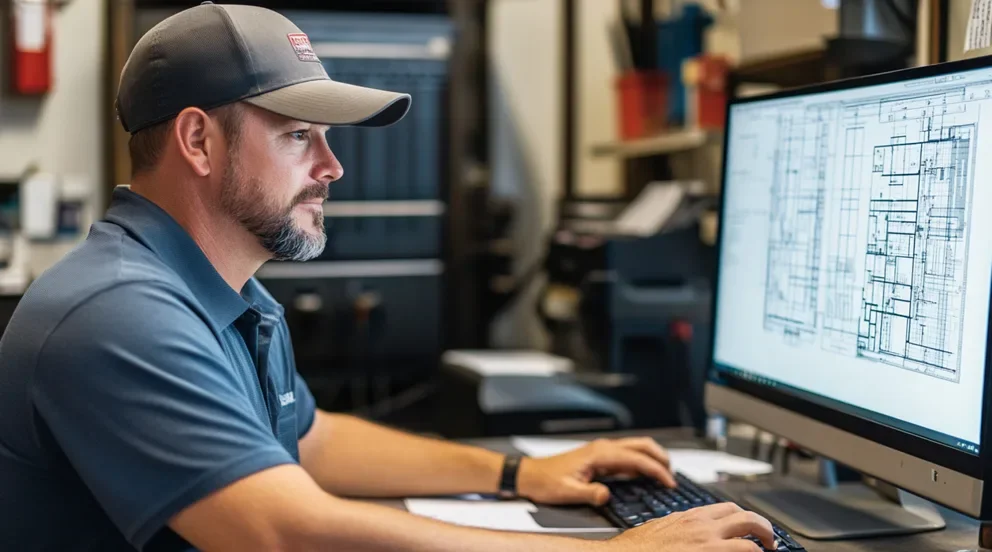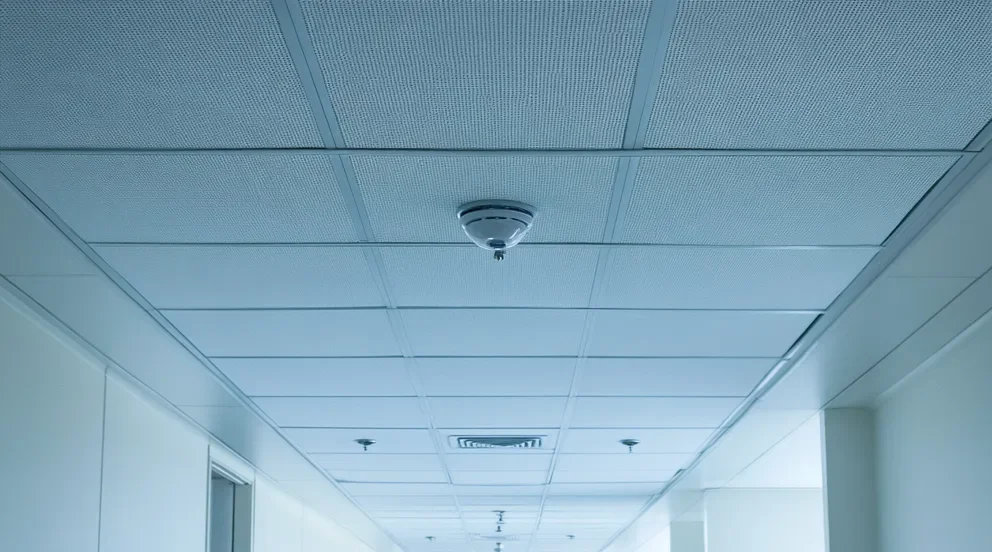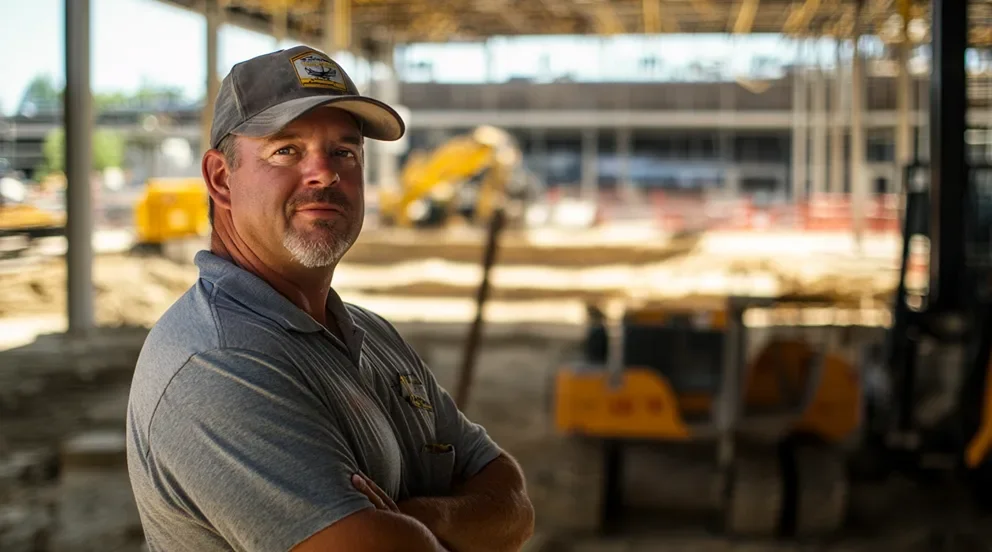If your commercial electrical bids still live in spreadsheets, it’s time for a better way to quote jobs, protect margins, and win the work. Manual methods don’t cut it when labor rates shift daily and projects demand fast, accurate takeoffs. That’s where the best commercial electrical estimating software comes in. These platforms give you control over costs, help avoid underbidding, and let your techs hit the ground running once the job is won.
For companies working in the electrical industry, the right estimating tool ties directly into scheduling, purchasing, project management, and billing. And if your estimating software can’t handle real-world complexity—like material escalations, change orders, or service work—it’s holding your business back.
This guide breaks down how to choose a commercial electrical estimating platform that fits your operation and walks through which tools stand out for commercial contractors running full-scale field service jobs. Here’s what we’ll cover:
- Choosing the right commercial electrical estimating software
- 5 key features to look for in an electrical estimating software
- 7 best commercial electrical estimating software solutions for contractors
- 6 benefits of using estimating software for commercial electrical projects
- 4 important commercial electrical estimating software FAQs answered
Ready to stop guessing and start quoting like a pro? Let’s dive into what to look for when choosing commercial electrical estimating software—and why getting this right changes the game for field teams and estimators alike.
Choosing the right commercial electrical estimating software
When you're quoting out commercial electrical projects—especially the ones with complex scopes, tight deadlines, and layers of approvals—there’s no room for weak estimating tools. The software you rely on can either tighten up your bids or leave your team scrambling to adjust in the field. Commercial electrical contractors don’t just need something that calculates numbers—they need the best commercial electrical estimating software that factors in real-world labor conditions, gear specs, vendor pricing, and change order flexibility.
Unlike basic estimating apps meant for residential jobs, commercial estimating software has to handle larger scopes, multiple crews, and jobsite variables that shift mid-project. Picking the wrong tool can lead to blown budgets and lost bids. This part of the guide walks through what teams need to consider before locking in a platform.
- Project complexity – Are you quoting multi-floor installs, high-voltage distribution, or tenant improvements? Does the software handle custom assemblies, gear swaps, and varied labor conditions? Can it adjust to change orders and scope creep on the fly?
- Integration needs – Does it connect with your accounting, purchasing, and job tracking systems? Can estimates sync with schedules and invoices? Is the estimating tool just a standalone app, or does it fit into your field service tech stack?
- Team workflow – Who's building the estimates—senior estimators, project managers, or field supervisors? Can multiple team members work on the same bid without overlap? How quickly can they build or edit a quote under pressure?
- Database accuracy – Is the material and labor database current with union rates, material pricing, and vendor-specific gear? Can you update it easily to reflect supplier changes? How much manual entry is needed just to keep it usable?
- Features – Does it support commercial takeoffs tied to full project scope—gear, feeders, panels, switchgear, and labor? Can estimates convert into work orders, purchase lists, and job schedules without extra steps? Does it give your field crews the info they need before stepping on-site—like materials, labor hours, and phase timelines? Is everything connected—from estimate to install to invoice—so your field service ops don’t skip a beat?
Getting estimating software dialed in doesn’t just help the office—it gives your techs a shot at executing clean installs without financial blowback. Next, let’s break down which features matter most when comparing options for commercial electrical estimating software.
5 key features to look for in an electrical estimating software
Commercial electrical contractors don’t just estimate jobs—they estimate phases, coordinate crews, and manage shifting scopes across high-pressure builds. When a single estimate controls everything from purchasing to project delivery, your software can’t afford to miss.
The best commercial electrical estimating software gives you more than just numbers. It connects your estimating with scheduling, dispatch, invoicing, and every other field operation that relies on it. Here’s what to look for in commercial electrical estimating software that actually supports the way your team builds and bids commercial work.
1. Scheduling and dispatch integration
Field service scheduling and dispatch software don’t just coordinate techs—they turn estimates into action. When estimating software integrates directly with scheduling and dispatch, you can take labor timelines from the quote and map them into the actual job calendar without extra steps or confusion.
Let’s say your estimator builds out a 6-week commercial switchgear install with three labor phases. With this feature, your dispatcher sees labor hours and crew needs directly from the estimate—and gets it scheduled without the back-and-forth. No double entry. No misaligned timelines.
2. Real-time job access through mobile
The technician mobile app should give commercial field crews direct access to estimates—materials, labor hours, install notes—without waiting for office handoffs. That connection between what's estimated and what's actually happening onsite is a must on commercial jobs. Think of a commercial crew tasked with overnight conduit pulls for a medical office buildout. Specs change late in the day, but the foreman opens the app, reviews the original estimate, checks materials listed, and confirms labor phasing before work starts. No guesswork. The job aligns with what was quoted, avoiding rework and call-ins.
3. Labor tracking matched to estimates
With time tracking baked into your estimating system, you can measure exactly how close your labor predictions are to real install hours—and make corrections while the project is still active. Say you're wiring a mid-rise office building and forecast 300 hours for device install and final connections. Two weeks in, time logs show 220 hours already used—and only 60% of the floors are complete. That insight lets you make labor adjustments or submit a scope revision before the budget slips.
4. Invoicing that mirrors quoted phases
Invoicing connected to your estimating platform ensures your billing reflects the phases, terms, and line items your customer approved—critical when billing on percent-complete or milestone draws. For instance, your crew wraps the rough-in stage of a hotel remodel. Instead of rebuilding invoices by hand, your PM pulls directly from the estimate: 40% of labor, all rough-in materials, and mobilization. No disputes, no delays—just clean billing that reflects the quote.
5. CRM built for commercial quoting
A commercial-focused CRM helps estimators track past bids, view scope history, and keep tabs on repeat customers with complex systems. It’s essential when you're quoting the same property across multiple phases or return work.Say your team is re-quoting a hospital wing after completing the central plant the year before. Instead of searching for old estimates and notes, your estimator opens the client record and sees every past quote, markup, and material escalation. You’re not just quoting fast—you’re quoting smarter.
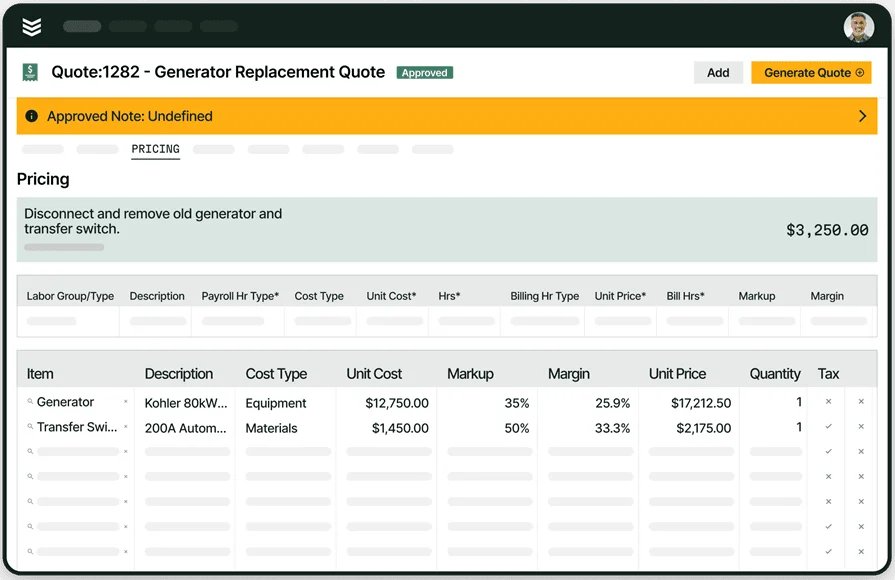
Superpower your workflows
See how we help bids become projects—and help you get them done fast.
Other valuable features to have in an electrical estimating software
The best commercial electrical estimating software doesn’t stop at quoting—it should also support the other areas of your business that impact project cost and job delivery. While the core features help build accurate estimates and move them into action, these supporting tools bring added value, especially when you're managing multiple projects, repeat clients, or contract-driven work. Here are a few commercial-focused features that can take your estimating workflow to the next level:
- Reporting tools – Reporting software helps your team track estimating accuracy, project profitability, and labor performance over time. This makes it easier to adjust future quotes and identify trends that impact margins.
- Service agreement support – Service agreements tied into estimating allow you to quote and manage recurring work—ideal for commercial clients needing annual testing, lighting checks, or equipment maintenance.
- Payments integration – With payment processing tools, you can link completed work and invoicing directly to payment collection. Especially useful on service-based commercial jobs, this reduces delays and tightens up cash flow.
Next, we’ll break down the 7 best commercial electrical estimating software solutions and how each one stacks up for contractors handling serious field work.
7 best commercial electrical estimating software solutions for contractors
Finding the best commercial electrical estimating software comes down to what your operation needs to control—whether that’s speed, scale, crew coordination, or billing accuracy. Some platforms specialize in precision takeoffs, others in project-wide workflows.
But if you’re working complex commercial jobs, from multi-floor office installs to retail tenant improvements, your estimating software should handle the full scale of the job—not just the numbers.
1. Best all-in-one platform for commercial contractors: BuildOps
BuildOps offers a full commercial electrical estimating solution that connects estimating with scheduling, dispatch, job costing, and invoicing—so your entire field service operation flows from the initial quote. It’s built for commercial contractors, giving estimators, PMs, and field techs access to the same data in real time. Estimating doesn’t happen in a vacuum here—it becomes the foundation for how work actually gets done.
How pricing works: Subscription-based pricing by user and feature needs. Annual agreements are standard.
Features beyond estimating: Includes full project management, scheduling and dispatch tools, service contract tracking, mobile field access, invoicing, and reporting. It also supports multi-location management and crew-specific scheduling, which is vital for commercial work.
What sets it apart for commercial: Built for high-volume, high-complexity work, BuildOps fits the way commercial contractors operate. Labor rates, phased billing, and field schedules are all tied into the original estimate. You’re not just quoting jobs—you’re managing margins from start to finish.
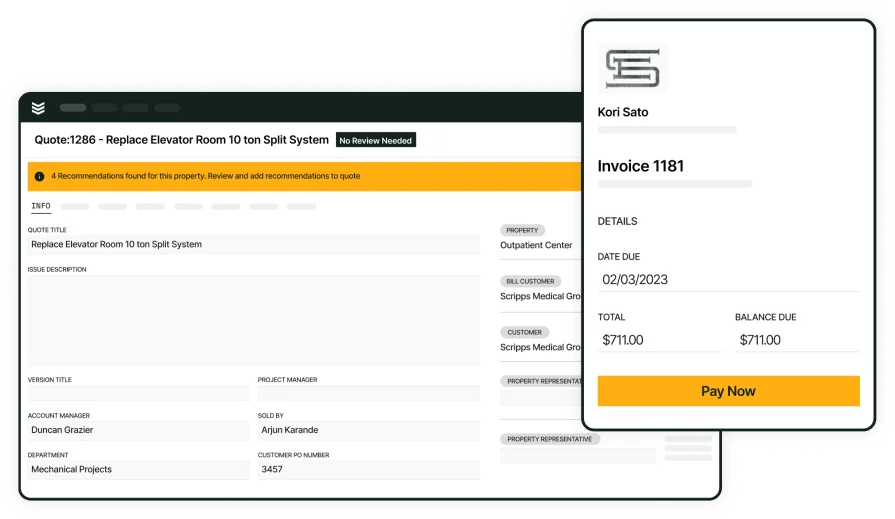
Connect Quoting to your workflow
Bids become projects—without losing job details.
2. Best for accurate takeoffs: PlanSwift
Image Source: PlanSwift
PlanSwift is a takeoff-first estimating platform designed to help commercial contractors build accurate material and labor counts from blueprints. Its drag-and-drop interface makes plan review and digital takeoff fast and efficient, ideal for crews working with detailed spec packages. That said, PlanSwift may not be ideal if you’re looking for built-in project management, dispatch, or scheduling—it’s focused strictly on estimating.
How pricing works: One-time license fee with optional annual maintenance costs. Typically around $1,600–$2,000 per seat.
Features beyond estimating: Plan-based takeoff tools, customizable assemblies, formula support, and integration with Excel.
What sets it apart for commercial: Great for contractors who self-perform and rely heavily on precise takeoff counts for materials and conduit planning.
3. Best for construction workflow: Accubid by Trimble
Image Source: Trimble Accubid
Accubid by Trimble is known for handling full-scope electrical estimating with strong emphasis on labor factoring, assemblies, and specification-level detail. It’s widely used by contractors bidding on large-scale commercial builds with multiple systems and coordination needs. However, Accubid may fall short for teams who want mobile access, integrated scheduling, or real-time field syncing—it leans heavily on the estimating side and less on field service ops.
How pricing works: Tiered licensing by module; costs vary based on features and user count.
Features beyond estimating: Database-driven assemblies, takeoff integration, bid summaries, and limited project tracking.
What sets it apart for commercial contractors: Useful when dealing with complex specs, union labor rates, and engineered drawings across multi-phase commercial installs.
4. Best for growing teams: Clear Estimates
Image Source: Clear Estimates
Clear Estimates offers a lightweight estimating tool designed for smaller commercial contractors looking to standardize quoting. It includes templates and preloaded pricing to help speed up estimate creation, particularly for service-based commercial work or tenant improvements. Still, Clear Estimates may not scale well for larger crews or teams managing scheduling, dispatch, or service agreements—those features are limited or require external tools.
How pricing works: Monthly subscription, usually around $59–$89/month depending on plan.
Features beyond estimating: Pre-built templates, cost updates, and simple customer management.
What sets it apart for commercial: Ideal for lean commercial contractors or service-focused electricians working short-scope quotes with recurring clients.
5. Best for electrical pre-construction: Procore
Image Source: Procore
Procore is a robust construction platform known for managing large-scale commercial projects from design through closeout. Its estimating capabilities sit within a broader ecosystem of tools that support RFIs, submittals, drawings, and pre-construction planning—ideal for firms handling multi-trade coordination or working closely with GCs and architects. However, Procore may not suit commercial electrical contractors looking for something estimating-focused or built specifically for field service workflows. It’s more geared toward construction managers overseeing the full build process.
How pricing works: Custom enterprise pricing based on company size, modules selected, and annual contract terms.
Features beyond estimating: Document control, submittals, bid management, financial tracking, and project scheduling across multiple trades.
What sets it apart for commercial: Useful for electrical contractors working as part of larger construction teams on design-build or complex tenant improvement jobs with heavy documentation needs.
6. Best for multi-trade contractors: STACK
Image Source: STACK
STACK offers a cloud-based takeoff and estimating platform with tools built for contractors handling multiple trades, including commercial electrical. It’s especially useful for companies bidding both electrical and low-voltage scopes, or managing bundled trade estimates under one umbrella. With browser-based access and real-time collaboration, STACK helps teams build estimates quickly from anywhere. Still, STACK may not be the best choice for commercial electricians needing connected scheduling, service agreements, or job costing—those features require integrations or external platforms.
How pricing works: Subscription model; pricing varies by user count and feature tier, typically starting around $2,999 per year for one user.
Features beyond estimating: Cloud takeoffs, multi-trade bid management, cost database tools, and collaboration for distributed teams.
What sets it apart for commercial: Great for firms that manage estimating across electrical, mechanical, or structured cabling scopes and need flexible takeoff tools to support all trades in one place.
7. Best for built-in database: Estimating Edge
Image Source: Estimating Edge
Estimating Edge stands out for its preloaded electrical database, which includes detailed labor units and materials for thousands of commercial components. This makes it especially effective for firms focused on fast, accurate estimates across a wide range of commercial job types—without needing to build assemblies from scratch. That said, Estimating Edge may not fit teams looking for connected dispatch, field tracking, or end-to-end service management—it’s strong in estimating but doesn’t support the full commercial workflow.
How pricing works: Per-user licensing model; one-time fee plus optional annual maintenance or cloud access upgrades.
Features beyond estimating: Preloaded commercial database, graphical takeoff tools, and reporting options for proposal breakdowns.
What sets it apart for commercial: Ideal for contractors who want detailed, database-driven commercial electrical estimates without needing to build every detail manually. It’s especially helpful for repeat bid types like lighting packages or panel upgrades.

Improve your estimating process
Get insights into leading processes, real-life examples, and templates.
6 benefits of using estimating software for commercial electrical projects
Commercial electrical contractors face more than just pricing out parts—they deal with phased schedules, labor-heavy scopes, and coordination across jobsites. Estimating tools that can’t keep up with that reality don’t just slow the process—they cost you jobs.
A quality commercial electrical estimating software brings a new level of control, accuracy, and visibility to how you quote and deliver commercial work. Here’s how custom-built commercial estimating tools give commercial teams the edge:
1. Faster turnaround on high-stakes bids
Commercial opportunities move fast—especially on negotiated bids and shortlists. Estimating software speeds up how quickly teams can price large-scale work, build proposals, and respond to updated specs. That time saved can be the difference between landing a hospital wing retrofit or losing it to a quicker competitor.
2. Better project handoffs from sales to field
When estimates live inside a disconnected spreadsheet, important context gets dropped the moment the job kicks off. With commercial estimating software, the transition from quote to execution is seamless—PMs, foremen, and dispatchers see what was sold and what’s expected. That kind of sync supports stronger handoffs and better results, especially when paired with commercial field service management software.
3. Fewer invoicing delays and billing disputes
Accurate estimating leads to accurate billing—especially when estimates are built with labor breakdowns, material details, and progress-based schedules in mind. Once the job starts, there’s no scrambling to explain what was included or chase down change orders. As this electrical contractor invoicing guide explains, clear quoting sets the tone for clear billing.
4. Visibility across complex project phases
Commercial jobs don’t happen in a day—and tracking estimating assumptions across three or four job phases gets messy fast. Estimating software gives PMs visibility into what was quoted for each stage of the job, so they can monitor margin, labor use, and costs without guessing. That visibility also ties into how commercial construction project management platforms maintain control from kickoff to closeout.
5. Stronger customer relationships with accurate proposals
Clients remember who delivers clean, accurate quotes—especially in repeat commercial work like retail chains or healthcare systems. Estimating tools help you build professional proposals with detailed breakdowns that show you understand their needs. Combined with commercial construction CRM, your team can track those details over time and keep relationships strong.
6. Easier tracking of historical job costs
Knowing how a job performed after it’s closed is what makes the next estimate sharper. Estimating software helps teams compare projected versus actual costs over time, making it easier to identify cost overruns, labor trends, or equipment issues that affect profitability. That historical data feeds smarter decisions on the next bid—especially when commercial margins are tight.
4 important commercial electrical estimating software FAQs answered
Estimating software plays a different role in the commercial world. You’re not just quoting a breaker swap—you’re pricing complex scopes, managing crews, and forecasting labor across job phases. That’s why the best commercial electrical estimating software doesn’t stop at takeoffs—it supports how your field and office teams plan, track, and close work at scale.
1. What is commercial electrical estimating software?
Commercial electrical estimating software helps contractors create accurate job estimates by combining labor, materials, equipment, and overhead into a structured quote tailored for large-scale projects. It supports tasks unique to commercial work, improving bid speed and pricing accuracy.
Unlike basic residential tools, commercial estimating platforms often integrate with project management, dispatching, and invoicing systems, allowing the estimate to carry through the entire job lifecycle. This keeps your pricing consistent, your schedules realistic, and your profits protected.
2. How does commercial electrical estimating software work?
Commercial estimating software is built to reflect how real projects unfold—especially when jobs span weeks or include multiple installs across one site. Here's how it typically works:
- Input Scope & Job Type: Start by entering project details—like square footage, system requirements, or phases.
- Select or Customize Assemblies: Choose from preloaded assemblies or create custom ones to match the install needs.
- Apply Labor & Material Costs: The tool pulls current labor units, wage rates, and material costs to build accurate totals.
- Review, Adjust, and Finalize: Estimators tweak line items, apply markups, and lock in profit margins before exporting the proposal.
- Sync with Operations: Once accepted, estimates can feed directly into job tracking, purchase orders, and crew schedules.
By syncing estimating with other parts of the business, commercial contractors can reduce gaps between what was quoted and what actually happens in the field.
3. Is estimating software worth the cost for commercial electricians?
Absolutely—especially for firms doing commercial tenant improvements, system upgrades, or full-scale builds. Here's why:
- It cuts down estimating time, letting your team quote more work without increasing headcount.
- It reduces errors tied to manual entry or outdated pricing.
- It protects margins by tracking labor trends, vendor pricing, and bid success rates.
- It supports better communication between sales, project management, and field teams.
The initial investment pays off when you’re quoting jobs faster, avoiding underbids, and keeping install work aligned with what you priced.
4. What are the best practices for using estimating software in commercial electrical work?
Here are 10 must-follow practices for getting the most out of the best commercial electrical estimating software:
- Use current labor and material pricing – Update databases regularly to reflect real-world costs.
- Build assemblies for common scopes – Speed up quoting by creating reusable groups for typical installs.
- Factor in access, layout, and working conditions – Labor estimates should match real jobsite complexity.
- Include general conditions and overhead – Don’t forget items like permits, rentals, and supervision costs.
- Review historical job data – Compare past job actuals to adjust future estimates more accurately.
- Keep notes tied to line items – Clarify assumptions so PMs know what was included and why.
- Involve your field team during estimate review – They know what install realities often get missed.
- Group estimates by phase or milestone – Makes progress billing and crew scheduling easier later.
- Use templates for repeat clients or scopes – Reduces guesswork and standardizes pricing across bids.
- Connect your estimate to operations tools – Push accepted quotes into project management and scheduling software.
Following these practices helps ensure your estimates hold up not just on paper—but all the way through project delivery.
Wrapping up large commercial electrical projects takes more than sharp estimates. It takes tight coordination across your office, crews, timelines, and tools. The best commercial electrical estimating software supports all of that—not just with pricing, but with how your team actually delivers the job. Most platforms on the market stop at takeoffs or spreadsheets. They don’t link your quotes to scheduling, invoicing, crew access, or service contracts.
That’s where all-in-one commercial platforms like BuildOps stand out. Everything mentioned in this guide—accurate labor breakdowns, real-time job sync, mobile-ready field tools, invoicing alignment, and service tracking—BuildOps brings all of it under one system, specifically built for commercial contractors. It’s not about stacking features—it’s about building a connected workflow that keeps your estimates profitable from day one.
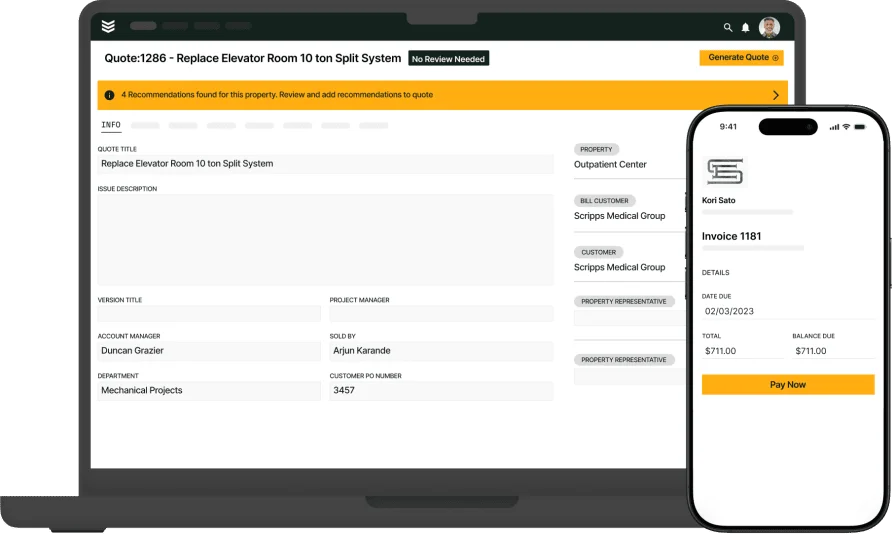
See how BuildOps fits your setup
See how commercial teams tighten their quoting process for more control.




